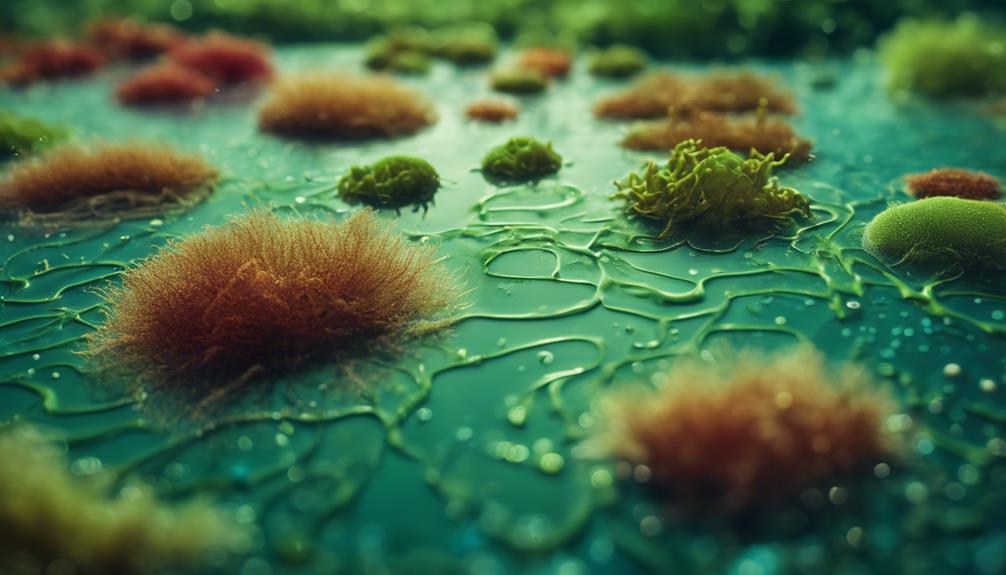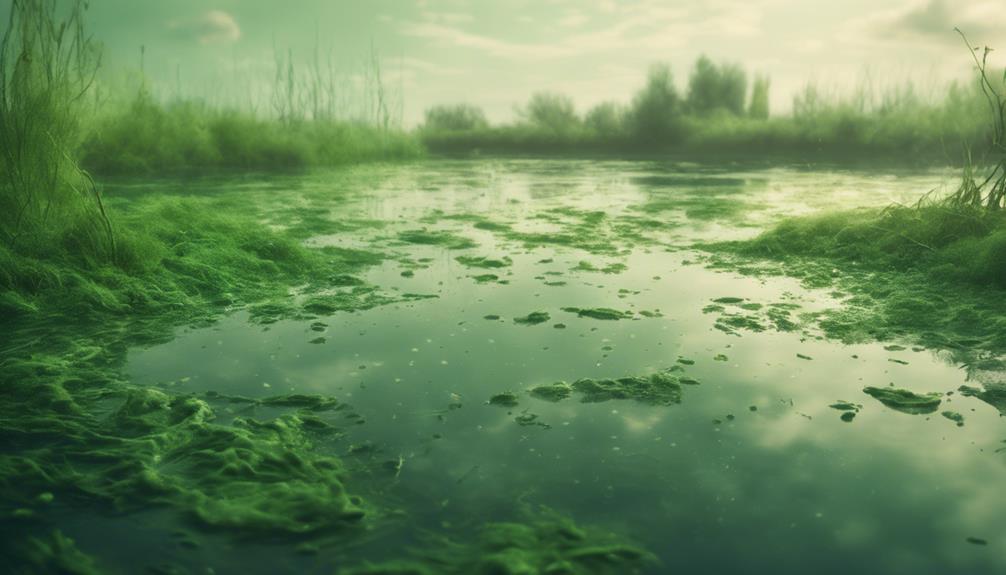You're surrounded by perfect storm conditions for algae growth – stagnant water bodies, high temperatures, and an overabundance of nutrients. These ideal conditions fuel rapid algae growth, depleting oxygen levels and releasing potent toxins that can harm aquatic life and human health. Excessive nutrients from human activities like agriculture and poor water circulation accelerate eutrophication, leading to long-term damage. To stop it, you must reduce nutrient runoff, implement real-time water quality monitoring, and use prevention strategies like artificial circulation and sustainable algae management practices. By understanding the causes, you're one step closer to uncovering effective solutions.
Table of Contents
Key Takeaways
- Algal blooms are fueled by excessive nutrients like nitrogen and phosphorus, which can deplete oxygen levels and reduce dissolved oxygen.
- Stagnant water bodies, high temperatures, and an overabundance of nutrients create an ideal environment for rapid algae growth.
- Reducing nutrient runoff into water bodies is imperative to prevent harmful algal blooms by addressing agricultural and sewage nutrient pollution.
- Implementing sustainable algae management practices, such as real-time water quality monitoring and artificial circulation, can help prevent algal blooms.
- A combination of methods that target the root causes of algal blooms, including aeration systems and upgraded sewage treatment plants, is necessary for effective algae control.
Understanding Algal Blooms
When you plunge into the world of aquatic ecosystems, it is vital to understand that algae are a natural and integral component, but certain conditions can trigger their rapid growth, resulting in algal blooms.
These blooms can be harmful, leading to freshwater deficiency, massive death of fish and other aquatic life, and the release of potent algal toxins that can cause human illness, paralysis, liver cancer, or even death.
As you explore water bodies, you'll find that algae growth is fueled by excessive nutrients like nitrogen and phosphorus, which can deplete oxygen levels and reduce dissolved oxygen.
This, in turn, can have devastating effects on water quality.
To prevent these harmful algal blooms, it is imperative to reduce nutrient runoff into water bodies.
By doing so, you can maintain healthy water bodies and prevent the negative impacts of algal blooms on the environment and human health.
Causes and Conditions of Algae
Stagnant water bodies, often plagued by high temperatures and an overabundance of nutrients, create an ideal environment that fosters the rapid growth of blue-green algae, ultimately leading to devastating algal blooms.
As you explore the causes of algae, you'll find that stagnant water, high temperatures, and excessive nutrients are the perfect storm for algae growth. These conditions allow blue-green algae to thrive, outcompeting other aquatic organisms for resources.
Human activities, such as agriculture, accelerate eutrophication, releasing stored nutrients into the water and causing long-term damage. Additionally, water reservoirs often lack circulation, leading to stagnant water that's conducive to algae growth.
Key to recognize that nutrient pollution is a significant contributor to algae growth, and addressing this issue is vital to preventing algal blooms. By understanding these causes, you'll be better equipped to take action and protect your water body from the devastating effects of algae.
Types and Characteristics of Algae

As you explore into the diverse world of algae, you'll discover that these aquatic organisms come in a variety of forms and characteristics, including planktonic, filamentous, and macrophytic types, each with unique features that set them apart.
| Type | Description | Characteristics |
|---|---|---|
| Planktonic | Microscopic, single-celled | Float in water or form colonies |
| Filamentous | Single-celled, hair-like mats | Form long, hair-like structures |
| Macrophytes | Resemble real plants | Stems, leaves, and varied pigmentation |
| Cyanobacteria | Blue-green algae, bacteria | Responsible for algae blooms in freshwaters |
| Green Algae | Various species, green pigmentation | Found in aquatic environments |
You'll notice that each type has distinct characteristics, such as pigmentation, size, and growth patterns. Understanding these differences is vital in identifying and addressing algae growth in your aquatic environment. By recognizing the type of algae present, you can take targeted steps to prevent and manage its growth.
Prevention and Management Strategies
By recognizing the type of algae present in your aquatic environment, you can take targeted steps to prevent and manage its growth, and this is where effective prevention and management strategies come into play.
Real-time water quality monitoring helps you track key parameters, allowing for trend forecasting and early intervention.
To prevent algal blooms, reducing nutrient loads to waterways is essential. You can achieve this by upgrading sewage treatment plants, tackling nutrient sources from agriculture, and implementing best management practices.
Artificial circulation can also be an effective method for reducing algal blooms in deep reservoirs.
In addition, implementing sustainable algae management practices that aim to reduce nutrient inflow in water bodies is critical. This requires changes in policies and human activities to minimize stormwater runoff and wastewater discharges.
A thorough approach that combines multiple prevention and management strategies is necessary to effectively prevent algal blooms. By adopting these strategies, you'll be well on your way to maintaining good water quality and preventing the growth of algae in your aquatic environment.
Solutions for Algae Control

Effective solutions for algae control involve a combination of methods that target the root causes of algal blooms, including reducing nutrient loads, optimizing water circulation, and utilizing innovative technologies to mitigate their growth.
You can take an exhaustive approach to preventing algal blooms by addressing the root causes.
Implementing aeration systems and artificial circulation to improve water management and reduce stagnation.
Using ultrasonic technology or chemical additives to inhibit algae growth, while being mindful of their potential drawbacks.
Upgrading sewage treatment plants to reduce nutrient loads in contaminated water.
Addressing nutrient contamination from agricultural sources, such as erosion and fertilizers, to prevent algal blooms in the long run.
Frequently Asked Questions
What Is the Main Cause of Algae?
You find that the main cause of algae is often excess nutrients in warm waters, triggered by overfertilization, poor circulation, and stagnant water, which creates a nutrient imbalance, ideal for algae growth.
What Is the Best Way to Stop Algae?
You'll find that debunking the myth that algae can't be fully eliminated is key; instead, try combining algae prevention methods like natural remedies, algae eaters, and beneficial bacteria with regular cleaning, water testing, and UV filters for ideal results.
What Makes Algae Go Away?
You can make algae go away by introducing algae eaters, manually removing it, or using water circulation, UV filters, oxidizers, algae scrapers, pool covers, or algae magnets, which can be informed by regular water testing to identify the best approach.
What Kills Algae Immediately?
You're in a pinch and need an algae emergency treatment, stat! Reach for these swift killers: artificial circulation, chemical algaecides, ultrasonic tech, alum, or ozonation – all instant eliminators that'll rapidly remove algae, saving your aquatic haven from these unwanted visitors.
Conclusion
Algae growth can be a pesky problem, but with the right strategies, you can regain control.
Think of it like taming a wild garden – with regular maintenance and attention, you can prevent overgrowth and keep your ecosystem thriving.
In fact, a study found that regular water testing and adjustments can reduce algae growth by up to 90%.
By applying the prevention and management techniques outlined above, you'll be well on your way to a balanced and healthy environment.

